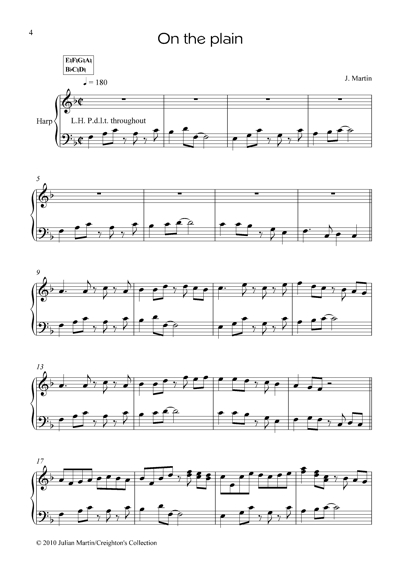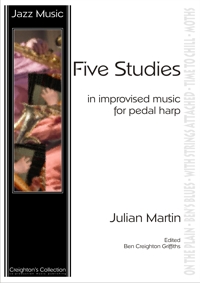Five
Studies in Improvised Music for Pedal Harp Buy this music now Score: £12.00 + p&p
|
| Click here for Artist Profile |
I'd like to give my personal thanks to my editor, Benjamin Creighton Griffiths, who has helped enormously with the development of these pieces, both as guinea pig and quality control inspector.
Contents
Composer's Notes (see below)
Explanation of Symbols used in the book
1. On the Plain
2. Ben's Blues
3. With Strings Attached
4. Time to Chill
5. Moths
Final Thoughts (list of further listening & reading)
-------------------------------------
Composer's Notes
Five studies in improvised
music for the pedal Harp
On the Plain
This is an African township style piece which uses three chords in the key of F. Effective improvisations can be done using the three notes that make up each chord in turn, so a great start would be to make sure you can play the arpeggios of each chord starting from the root, third and fifth. It can also be a good idea to include the 7th in the C arpeggio (eg: B flat), as this gives a nice dominant feel as we come back to the F chord in the fourth bar of the sequence.
As this is quite a repetitive sequence, try starting fairly simply, maybe using the simplified L.H pattern, then building slowly until you're throwing everything you have at it.
A good tune to listen to in this style would be Mandela by Abdullah Ibrahim.
Ben's Blues
This is a standard basic 12 bar blues form. As with “On the Plain”, a good starting strategy for soloing is to target the chord tones of each passing chord to construct a simple new melody. In blues, however, it's good to include the seventh of each chord as well. (eg: B flat for C7, E flat for F7 and F for G) As the chords change try to find a note in the new chord that is nearby, rather than simply using the same pattern rooted in the next chord that comes along in a new position.
On top of this strategy we can add extra colour by using the Blues Scale: C D# F F# G Bb C. The given tuning doesn't give us the F# (or “Blue note”), so we need to achieve this using a pedal slide.
Eighth notes should be played with a swing (triplet) feel. Try listening to Milt Jackson's “Bag's Groove as played by Miles Davis on the album “A Day in Paris” to hear how this sounds, along with some good examples of outlining chords with occasional Blues scale references.
With Strings Attached
This is a groove based piece similar to Herbie Hancock's “Cantaloupe Island” in its intended feel. Play with a straight 8ths feel, keeping ideas simple and as rhythmically tight as you can.
Time to chill
A Bossa Nova. Like “With strings attached” this is played with a straight feel. Using chord outlines can be very effective here, as can scalar passages from the prevailing key. In the left hand pattern beats one and three can be played heavily with the approach quavers barely alluded to. This gives a more traditional feel similar to a surdo (bass drum) pattern that would be used in Brazilian music.
The soloing section has been simplified here to make it slightly easier to negotiate. This is not as uncommon in jazz as one might think.
Try listening to any recordings by Antonio Carlos Jobim to get a better idea of the intended feel of this tune, particularly his slower work such as “Dindi”.
Moths
This is a jazz waltz, played with a swing feel. You can use the same approaches as the other tunes for soloing, playing around the open section as many times as you want using the prevailing tuning. It can be effective to play the first 16 bars of the solo section using scalar passages, and then switch to chord outlining for the remainder of the section.
For a good example of jazz waltz playing listen to Bill Evans playing his own “Waltz for Debbie” Listen carefully though. A favourite trick of his was to alternate between 3/4 and 4/4 with each new chorus of improvising.

| Title: | Five Studies in Improvised Music for Pedal Harp |
| Works: | 5 (See contents section above for details) |
| Composer: | Julian Martin |
| Editor | Benjamin Creighton Griffiths |
| Instrumentation: | Pedal Harp |
| Level: | Intermediate - Advanced |
| Format: | Score |
| Size: | A4 Stapled |
| Pages: | 24 |
| Weight: | 108gm |
| ISMN: | M-57046-015-1 |
| Our Ref: | SM0254 |
| Publisher: | Creighton's Collection |
| Edition/Year: | 2010 |
| Origin: | UK |
| Sheet Music | ||
 |
||
| Five Studies |
||
| Click here for Artist Profile | ||
Click here to see all CDs, DVDs & Sheet Music by Ben Creighton Griffiths
 Five
Studies in Improvised Music for Pedal Harp is aimed at the more
advanced harpist who wishes to try their hand at improvised jazz.
The tunes themselves are also ideal for the more experienced
Jazz Harpist looking for new material.
Five
Studies in Improvised Music for Pedal Harp is aimed at the more
advanced harpist who wishes to try their hand at improvised jazz.
The tunes themselves are also ideal for the more experienced
Jazz Harpist looking for new material.